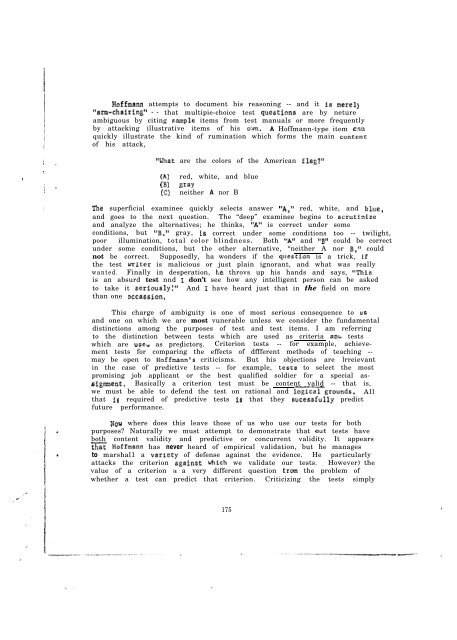Technical Report - International Military Testing Association
Technical Report - International Military Testing Association
Technical Report - International Military Testing Association
You also want an ePaper? Increase the reach of your titles
YUMPU automatically turns print PDFs into web optimized ePapers that Google loves.
f<br />
Ih<br />
i<br />
i<br />
Hoffmann attempts to document his reasoning -- and it in mere11<br />
U’arm-chairing” -- that multipie-choice test qucctitions are by neture<br />
ambiguous by citing Pample items from test manuals or more frequently<br />
by attacking illustrative items of his 0.m. A Hoffmann-type item C.W<br />
quickly illustrate the kind of rumination which forms the main content<br />
of his attack,<br />
i<br />
.<br />
I .<br />
Watt are the colors of the American flag?”<br />
(A) red, white, and blue<br />
i<br />
c<br />
, 0)<br />
((3<br />
say<br />
neither A nor B<br />
i The superficial examinee quickly selects answer “A,” red, white, and blue,<br />
and goes to the next question. The “deep” examinee begins to scrutinize<br />
and analyze the alternatives; he thinks, “A” is correct under some<br />
conditions, but “B,” gray, Is correct under some conditions too -- twilight,<br />
poor illumination, total color blindness. Both “A” and “B” could be correct<br />
under some conditions, but the other alternative, “neither A nor B,” could<br />
not be correct. Supposedly, ha wonders if the questfon is a trick, if<br />
the test wrftcr is malicious or just plain ignorant, and what was really<br />
wanted. Finally in desperation, t,e throvs up his hands and says, llThie<br />
is an absurd test nnd 1 don’t see how any intelligent person can be asked<br />
to take it seriouslylf’ And 1 have heard just that in the field on more<br />
than one occassion.<br />
This charge of ambiguity is one of most serious consequence to us<br />
and one on which we are most vunerable unless we consider the fundamental<br />
distinctions among the purposes of test and test items. I am referring<br />
to the distinction between tests which are used as criteria ant. tests<br />
which are u6eu as predictors. - -<br />
Criterion tests -- for example, achievement<br />
tests for comparing the effects of dffferent methods of teaching -may<br />
be open to Hoffmann’s criticisms. But his objections are lrreievant<br />
in the case of predictive tests -- for example, tests to select the most<br />
promising job applicant or the best qualified soldier for a special assignment.<br />
Basically a criterion test must be content valid -- that is,<br />
we must be able to defend the test on rational and logicalgrounds. All<br />
that fs required of predictive tests is that they sucessfully predict<br />
future performance.<br />
Now where does this leave those of us who use our tests for both<br />
purposes? Naturally we must attempt to demonstrate that vdt tests have<br />
both content validity and predictive or concurrent validity. It appears<br />
chet Hoffmann has never heard of empirical validation, but he manages<br />
to marshal1 a variety of defense against the evidence. He particularly<br />
attacks the criterion sgainst which we validate our tests. However) the<br />
value of a criterion is a very different question frocn the problem of<br />
whether a test can predict that criterion. Criticizing the tests simply<br />
175<br />
t









